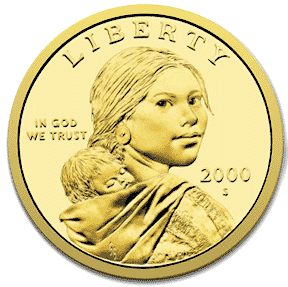 Another Stereotype of the Month entry:
Another Stereotype of the Month entry:
 Another Stereotype of the Month entry:
Another Stereotype of the Month entry:
'Sacagawea' falls short on illumination
01/14/03
MICHAEL McGREGOR
Few women played as prominent a role in early American history as Sacagawea. Fewer still who weren't white.
Every schoolchild knows her name. And with good reason: Without her interpreting skills, Lewis and Clark might never have reached the Pacific Ocean.
Sadly, we know little about her, and what we do know was written by whites. As a result, she is often portrayed not as a real Native American woman but only as a symbol.
In creating "Sacagawea" for the Oregon Children's Theatre, playwright Eric Coble seems to have been aware of this problem. His goal, he says in his playbill notes, was to render "the emotional truth of a young woman's experiences."
Unfortunately, his play conveys neither Sacagawea's significance nor any sense that we are seeing the world through her eyes.
The play begins with Sacagawea (Chenoa Egawa) bantering with her family in her native Shoshone village. Within minutes, Hidatsa warriors have captured her and sold her to the trapper Charbonneau (Alan King). The two soon join the Lewis and Clark expedition, and the play settles into a familiar recitation of the expedition's hardships.
Though raised on U.S. reservations where his mother taught school, Coble shows little feeling for the uniqueness of Sacagawea's position or how strange the white world must have been to her. Instead of imagining the world through her Shoshone eyes, he looks at her through the lens of today's world.
Sacagawea and her brother Cameahwait (Francisco Garcia) bicker like Brady Bunch children. Later, after years apart, he greets her as if she has been away at college. William Clark coos over her baby like a suburban uncle, and at one point Sacagawea jokes that Charbonneau takes a bath once a month "whether he needs it or not."
Coble's script is full of such lazy dialogue and, what is worse, such a contemporary American viewpoint. But it is just one of the show's problems. Director Stan Foote's actors deliver most of their lines standing still, and the lighting and set, little more than a backdrop of mountains and rocks, are too spare to add meaning.
The musical choices are especially maddening. Lovely Native American songs sung by Egawa and Karen Kitchen (as a narrating contemporary grandmother) are kept brief, but an inanity with the refrain "Way, hey, away we go, donkey riding, donkey riding" goes on and on, even when the characters sail in a boat.
Children's theater has unique demands. But children don't need a story patterned on animated films or stock characters like Coble's Charbonneau, a bumbling French clown who sings silly ditties. Even the very young can appreciate the strangeness of a voice from the past.
Sadly, Sacagawea still waits to speak. Reach Michael McGregor c/o The Oregonian A&E, 1320 S.W. Broadway, Portland, OR 97201.
Reprinted by permission of the author.Rob's comment
The idea that modern people see the world as pre-modern people do, or that white people see the world as Indians do, is part of the problem here.
Related links
Indian women as sex objects
|
. . . |

|
All material © copyright its original owners, except where noted.
Original text and pictures © copyright 2007 by Robert Schmidt.
Copyrighted material is posted under the Fair Use provision of the Copyright Act,
which allows copying for nonprofit educational uses including criticism and commentary.
Comments sent to the publisher become the property of Blue Corn Comics
and may be used in other postings without permission.